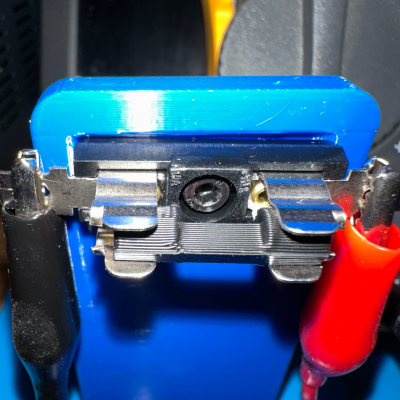After a quiet week in the news cycle, surveillance concern Flock jumped right back in with both feet, announcing a strategic partnership with Amazon’s Ring to integrate that company’s network of doorbell cameras into one all-seeing digital panopticon. Previously, we’d covered both Flock’s “UAVs as a service” model for combating retail theft from above, as well as the somewhat grassroots effort to fight back at the company’s wide-ranging network of license plate reader cameras. The Ring deal is not quite as “in your face” as drones chasing shoplifters, but it’s perhaps a bit more alarming, as it gives U.S. law enforcement agencies easy access to the Ring Community Request program directly through the Flock software that they (probably) already use.
2025 Component Abuse Challenge: Conductive Filament Makes A Meltable Fuse
Everything is a fuse if you run enough current through it. Or at least [JohnsonFarms.us] seems to think so, which has led him to design 3D-printed fuses made from conductive PLA filament.

In theory a 3D printed fuse works the same as a normal one: excessive current draw will cause the conductive plastic to briefly become a heater, causing it to self-destruct and break the electrical connection. There’s a risk of melted plastic and perhaps a nonzero combustion risk, but [JohnsonFarms.us] is less interested in whether this is a good idea and more interested in whether it can work at all, and with what degree of predictability and/or regret.
His experiments so far show that printed fuses are essentially meltable resistors with values between 300 Ω and 1250 Ω, depending on shape. What it takes to bring those to roughly 60 °C, where PLA softens, and around 150 °C, where PLA melts, is next on the to-do list.
Whatever conclusions are reached, it is interesting to think of conductive filament as a meltable resistor, and ponder what unusual applications that might allow.
Most conductive filaments have high resistance, but not all. Some, like Electrifi by Multi3D, have extremely low resistance and were used in a project that made 3d-printed logic gates.
The MSL10 Mechanosensor Makes Venus Flytrap Plants Touchy
Carnivorous plants are a fascinating part of the natural world, especially species like the Venus flytrap (Dionaea muscipula) that rely on what is effectively a spring-loaded trap to ensnare unsuspecting prey. As also seen with species like the waterwheel plant (Aldrovanda vesiculosa), species like sundews are a lot more chill with movement in the order of seconds, excluding D. glanduligera which displays a similar sub-second response as the Venus flytrap. Over the years there has been much speculation about the exact mechanism that enables such a fast response, with [Hiraku Suda] and colleagues offering an explanation, via a recently published paper in Nature Communications.

The sensory hairs that line the Venus flytrap’s leaves are finely tuned to respond to certain kind of stimuli using calcium threshold signals. This is something which was previously known already, but the exact mechanism still proved to be elusive.
This new study shows that a mechanosensor called DmMSL10 lies at the core of the touchiness of these plants by breeding a version where this particular stretch-activated chloride ion (Cl–) channel is absent.
While the mechanical action of the sensor hair triggers the release of calcium ions in both the wild- and knockout dmmsl10 variant, the action potential generation rate was much lower in the latter, while the former continued to generate action potentials even after major stimulation had ceased. This demonstrates that DmMSL10 is essential for the processing of slight stimulation of the sensor hairs and thus prey detection.
A subsequent experiment with some ants being allowed to wander around on the leaves of the wild- and knockout type plants further served to demonstrate the point, with the wild type catching the first ant to waddle onto the leaf, while the knockout type leaf didn’t even twitch as four successive ants failed to propagate the calcium signal sufficiently to close the leaf.
With this knowledge we now have a likely mechanism for how D. muscipula and friends are able to generate the long range calcium signals that ultimately allow them to snack on these tasty protein-and-nitrogen packets on legs. Further research is likely to illuminate how exactly these mechanisms were evolved in parallel with similar mechanisms in animals.
Filming At The Speed Of Light, About One Foot Per Nanosecond
[Brian Haidet] published on his AlphaPhoenix channel a laser beam recorded at 2 billion frames per second. Well, sort of. The catch? It’s only a one pixel by one pixel video, but he repeats it over and over to build up the full rendering. It’s a fascinating experiment and a delightful result.
For this project [Brian] went back to the drawing board and rebuilt his entire apparatus from scratch. You see in December last year he had already made a video camera that ran at 1,000,000,000 fps. This time around, in order to hit 2,000,000,000 fps at significantly improved resolution, [Brian] updated the motors, the hardware, the oscilloscope, the signalling, the recording software, and the processing software. Basically, everything.
One of the coolest effects to come out of this new setup is how light appears to travel noticeably faster when coming towards the camera than when moving away from it. It’s an artifact of the setup: laser beams that reflect off of fog particles closer to the camera arrive sooner than ones that bounce back from further away. Or, put another way, it’s special relativity visualized in an experiment in [Brian]’s garage. Pretty cool.
If you found all this intriguing and would like to know more, there’s some bonus material that goes into much more depth.
Decoding A 350 Year Old Coded Message
Usually, a story about hacking a coded message will have some computer element or, at least, a machine like an Enigma. But [Ruth Selman] recently posted a challenge asking if anyone could decrypt an English diplomatic message sent from France in 1670. Turns out, two teams managed it. Well, more accurately, one team of three people managed it, plus another lone cryptographer. If you want to try decoding it yourself, you might want to read [Ruth’s] first post and take a shot at it before reading on further here: there are spoilers below.
No computers or machines were likely used to create the message, although we imagine the codebreakers may have had some mechanized aids. Still, it takes human intuition to pull something like this off. One trick used by the text was the inclusion of letters meant to be thrown out. Because there were an odd number of Qs, and many of them were near the right margin, there was a suspicion that the Qs indicated a throw-away character and an end of line.
JLCPCB Locking Accounts, Mentions “Risky IP Addresses, Activities”
In the past week, a few forum and Reddit threads have popped up, with people stating that JLCPCB has emailed them with a notice, saying their accounts are set up for terminations after an assessment by JLCPCB’s “Risk Control Team”. Reasons given are vague, the terminations are non-appealable, and if you’re planning a JLCPCB order sometime soon, it can certainly come as a surprise. From the looks of it, the accounts restricted do not appear to be tied to any specific country – and not even from the same “kind” of countries.
As quite a few people have observed, the JLCPCB reasoning resembles a compliance action way more than it resembles any sort of internal policy. A few days ago, JLCPCB has released a statement on their blog, claiming that a “history of risky IP addresses and risky activities” would be grounds for a termination, and mentioning “compliance” in ways that would hint at external legal pressures.
By now, quickly checking around Reddit and some other places, we’ve counted at least ten people affected so far – most of them have received emails about account closures, but at least one person has reported a denial when attempting to place an order, instead of getting an email ahead of time. The latter hints that there’s a number of people not yet notified about their account getting terminated, and the amount of people actually affected might very well be a fair bit larger than we can see.
Continue reading “JLCPCB Locking Accounts, Mentions “Risky IP Addresses, Activities””
Was The Napier Nomad The Most Complex Aero Engine Ever Made?
From 1945 to 1955, a British aeronautical company called Napier & Son produced not just one but two versions of an intricate hybrid piston engine, which they named the Napier Nomad. The post-World War II era saw the development of several fascinating (and highly complex) piston-powered aeronautical engines alongside the emerging gas turbine engine designs. During this period, gas turbines were inefficient, unreliable, and primarily used for military applications. The (then) British Ministry of Supply commissioned the design and creation of a more fuel-efficient piston engine for aeronautical purposes, both military and civil, aiming to achieve gas turbine-like power while maintaining piston engine efficiency. Quite the challenge!
The specification aimed for 6000 hp and optimal fuel efficiency for long-range use. Napier knew gas turbines were limited by maximum operating temperature, constrained by available materials, which increased fuel consumption and reduced range. Piston engines operated at higher peak temperatures. They considered combining both principles to create a superior design, a concept suggested by aeronautical engineer Sir Harry Ricardo, who had consulted for Napier on other projects. Their complex solution was to build a gas turbine with a two-stroke diesel engine as the combustion chamber, merging the benefits of both.
Continue reading “Was The Napier Nomad The Most Complex Aero Engine Ever Made?”


















